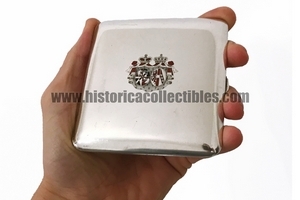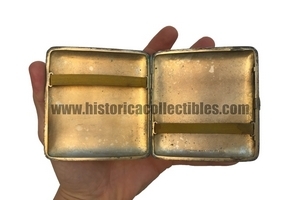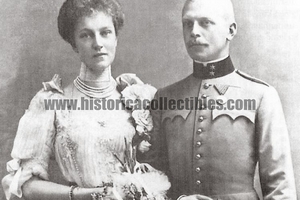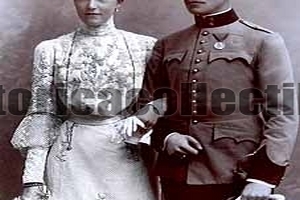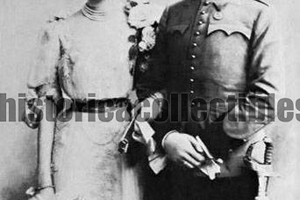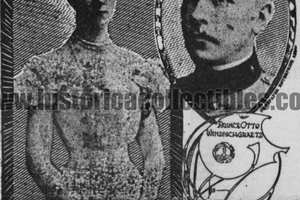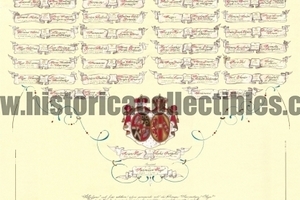Cigarette case Elisabeth Maria of Habsburg-Lorraine & Otto Weriand zu Windisch-Grätz, 1902
Silver cigarette case that belonged to Archduchess Elisabeth Maria of Habsburg-Lorraine, Princess of Windisch-Graetz, granddaughter of Emperor Franz Joseph and Princess Sissy and only daughter of Crown Prince Rudolf. This extraordinary cigarette case, made by the silversmith of the Imperial House "L. SCHUCH'S NCHFG. G. EDLAUER WIEN", was given to the Princess on the occasion of her marriage to Otto Weriand zu Windisch-Grätz in 1902.
In fact, the lid is engraved with the emblems, finished in fine Viennese enamel, of the 2 houses: Habsburg and Windisch-Graetz. There is another heirloom, preserved in another important private collection, linked to their marriage which took place in 1902: it is a small gold watch bearing the same set of emblems auctioned at Sotheby's.
The cigarette case also features the silversmith's hallmarks "GL", the Vienna "Diana" hallmark used from 1872 until 1922.
Its dimensions are 9.5 cm x 9 cm.
Elisabetta Maria Henrietta Stefania Gisella of Habsburg-Lorraine (Laxenburg, 2 September 1883 – Vienna, 16 March 1963) was an Archduchess of Austria and the only daughter of Hereditary Prince Rudolf of Austria. In her family she was known as Erzsi, a diminutive of her name in Hungarian. She later nicknamed herself "The Red Archduchess" for becoming a socialist and member of the Social Democratic Party of Austria.
Childhood: Elizabeth was born at Laxenburg Castle on 2 September 1883 to Rudolf and Princess Stephanie, daughter of Leopold II of Belgium. The only daughter of her (deceased) son, Erzsi, diminutive from the Hungarian Erzebet, was the favorite granddaughter of her paternal grandfather, Emperor Franz Joseph of Austria.
In 1889, when Erzsi was just over five years old, his father and his lover Baroness Maria Vetsera were found dead in what was presumed to be a murder-suicide pact in the imperial hunting lodge of Mayerling. The death of her father interrupted the dynastic succession within the Austrian imperial family of Habsburg-Lorraine, fracturing the already precarious marital situation of her grandparents.
After Rudolf's death, Franz Joseph assumed her guardianship; by her order, she was forbidden to leave Austria with her mother. At a young age she displayed a strong personality, as well as an opposition to the Viennese court.
Her grandmother, the beautiful and capricious Empress Elizabeth, did not like to be identified as a grandmother and had superficial relationships with her grandchildren, even with Elizabeth, but she strove, when she was at court, to play the role of affectionate grandmother to please Franz Joseph who adored his niece.
Upon her death, the Empress divided her estate between her daughters Gisella and Maria Valeria (two fifths each) and her granddaughter Elizabeth (one fifth) (see diary of Archduchess Maria Valeria). Elisabetta also gave her niece Erzi a series of her famous diamond stars, which also appeared among the wedding gifts of the young Archduchess. The Empress demonstrated her contempt for her daughter-in-law before the scandal, and after Mayerling she blamed Stephanie's jealous attitude for her son's unhappiness and for her suicide.
Rudolph's wife, Crown Princess Stephanie, mother of the young Archduchess Elizabeth, was completely dependent on the emperor's charity. After Rudolf's death, the resulting lack of imperial support for Stephanie negatively affected Elizabeth's relationship with her mother, so parent and daughter were never close.
In 1900 Stefania renounced her title of Hereditary Princess to marry the young – and Protestant – Hungarian count Elemer Lonyay. Although Franz Joseph provided her with a dowry and Lonyay subsequently converted her, Elizabeth broke off all contact with her mother as she regarded the marriage as a betrayal of her father's memory. Later, in 1934, Stefania took revenge by disinheriting Elizabeth, her only daughter.
First Marriage: The Belgian royal court considered Elizabeth as a possible bride for Prince Albert, heir presumptive to the Belgian throne; but King Leopold II who violently disapproved of his mother's recent morganatic marriage to Count Lonyay, refused to give Albert her permission.
Alberto's sister Enrichetta was horrified by her choice of brother, feeling that Elisabetta's environment was too unstable for a successful marriage.
Around that time, Elizabeth met Prince Otto zu Windisch-Graetz (1873–1952) at a court ball. Ten years her senior, he was far below her rank. Nonetheless, Elizabeth pestered Franz Joseph to give her permission to marry him; he agreed. By many accounts it was only Elizabeth who wanted marriage; Otto was already engaged to another woman and was stunned when his Emperor informed him of his new engagement. He was ordered by the Emperor to break off his "minor" engagement and marry his niece: he obeyed.
In order to avoid future succession disputes, the Emperor forced Elizabeth to renounce her dynastic rights, although he allowed her to retain her personal titles and provided her with a generous dowry. In fact, the Habsburgs did not consider the House of Otto as their equals and for this reason it was necessary that the marriage was morganatic, so that no pressure was put on Elizabeth to become Empress, if the succession was interrupted again.
The couple married at the Hofburg on 23 January 1902. The marriage, however, was troubled, and brought the emperor unpleasant memories of his son's death, and subsequent further scandal for the family:
"Your granddaughter recently married Prince Windisch-Graetz; she was the only daughter of the late Crown Prince Rudolf. The marriage was a union of love, but when they had been married for just a year, they fell out, due to a actress who was shot by Princess Elizabeth: the woman died from her injuries. The Emperor, as a consequence of this event, did not attend the baptism of the son of Archduchess Princess Windisch-Graetz. The affair caused a painful sensation at the Court of Vienna , even if it was hushed up as most such events are."
The Red Archduchess: Both Erzsi and Otto were open about having extramarital affairs with each other and Elizabeth's liaison with Egon Lerch, an Austrian submarine captain during World War I, is particularly notable.
It was only after the death of Franz Joseph in 1916 and the end of the monarchy in 1918 that the couple officially separated. In 1921 Elizabeth joined the Social Democratic Party and met Leopold Petznek from Bruck an der Leitha, then president of the Court of Auditors, in one of the electoral meetings. A teacher and staunch social democrat, Petznek came from a modest background but was very polite. He was also married: his wife (with whom he had had a son), had been committed to a psychiatric hospital in Mauer-Ohling and died there on 9 June 1935.
The legal proceedings dragged on for a long time and only in March 1924 was Elizabeth able to obtain an official separation. A sensational custody battle ensued over their four children. Originally the court awarded Elizabeth custody of the two eldest sons, while the youngest son and her daughter went to live with Otto.
Second Marriage: Elizabeth officially divorced Prince Otto and on 4 May 1948 she married Leopold Petznek (1881-1956), with whom she had lived for many years. He, who had spent time imprisoned by the Nazis, became president of the Lower Austrian Landtag after the war.
Elizabeth became known as the Red Archduchess (German: Die rote Erzherzogin) due to her association with her husband Leopold and the Socialist Party. She frequently visited spiritualists, and noted these seances in her diary.
Elizabeth died in Vienna on 16 March 1963 approximately six months before her eightieth birthday. According to her wishes, she was buried in an unmarked grave at the Hütteldorfer cemetery in Vienna, near the house where she had spent her last years with her huge dogs.
Elizabeth and Otto had four children:
- Franz Joseph (1904–1981);
- Ernst (1905–1952);
- Rudolf (1907–1939);
- Stephanie (1909–2005), unica figlia femmina della coppia, che nacque a Ploschkowitz.

